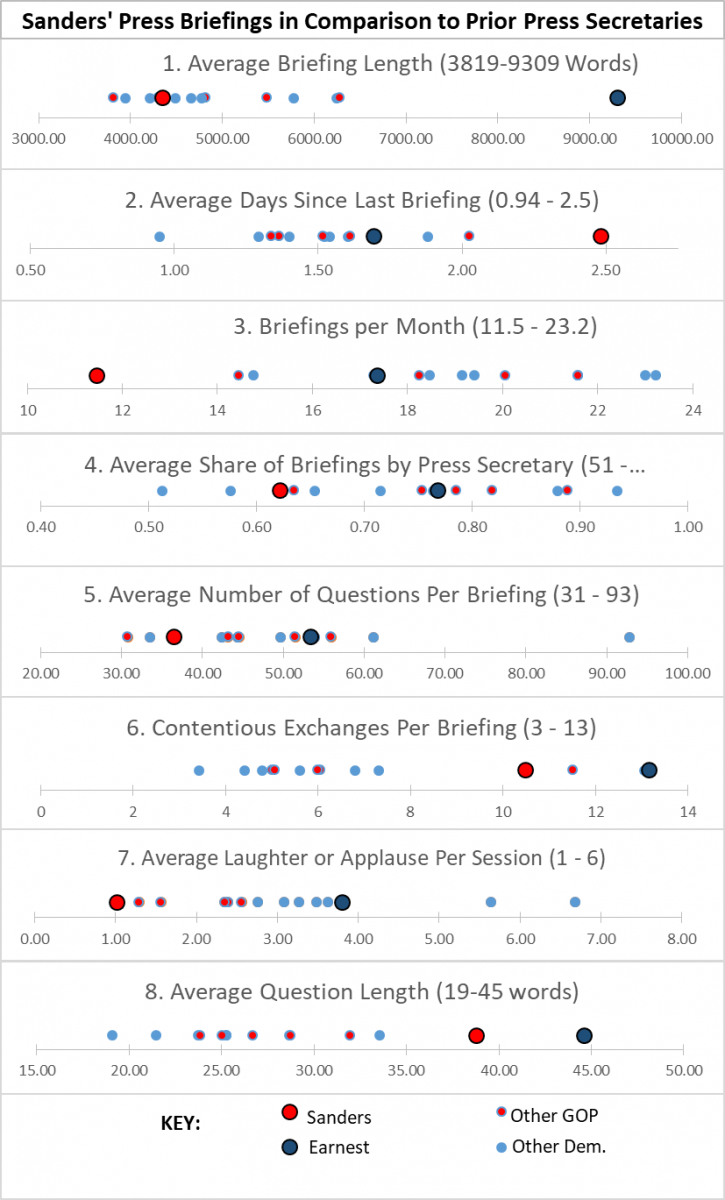How different are Trump Administration press Secretary Sarah Sanders's press briefings? Recently, The Washington Post presented both an analysis and an editorial critical of Sanders' briefings. The Post presented data contrasting Sanders with her two immediate predecessors, Sean Spicer and Josh Earnest. (Earnest was the last of Obama's press secretaries.)
But those comparisons are limited in time. This APP analysis looks at press secretaries starting with the Clinton Administration. 1/ We show that Sanders is both more and less remarkable than she seems from the comparison with Earnest alone.
We have analyzed 6091 verbatim transcripts of all press briefings with at least one reporter question starting with Clinton and extending through September 20 of 2018. In this analysis, we compare Sanders and her predecessors on eight dimensions. Below is a set of graphs showing our findings. Republican press secretaries are indicated with red dots, Democratic with blue. Both Sanders and Earnest are indicated with bigger circles.
1. Briefing length. While Sanders-era briefings are much shorter than Earnest's, they are well within the range of experience over the past quarter-century.
2 Length of time since the last briefing. In the Sanders era, the length of time between briefings is longer than any of the preceding 13 press secretaries. If we had measured only the briefings in person by the Press Secretary, the time would have been nearly doubled for Sanders.
3. Briefings per month. The Sanders era has had far fewer press briefings than any predecessor, including Sean Spicer, whose data point is hidden behind Earnest's.
4. Proportion of briefings by the press secretary. In every administration, there are lots of briefings, many by senior administration officials and deputy press secretaries. By this indicator, Sanders is below the median, but others have been present even less.
5. Average number of questions per briefing. Again Sanders is below the median, but two others had shorter briefings on average.
6. Contentious exchanges with reporters. This is a count of all statements suggesting doubts about honesty, completeness, bias, or deflecting and refusing to answer questions.[1] The Earnest era is the observed peak—recall the Benghazi incident for example. Sanders is well above the median.
7. Reports of laughter or applause. The briefing transcripts note laughter and applause, which probably gives a good sense of the tone of the interchanges. While Earnest was well above the median, all press secretaries serving Republican presidents were below the median, with Sanders at the bottom.
8. Average length of reporter questions. For whatever reason, reporters have in recent years tended to ask longer questions. Both Earnest and Sanders top the chart for facing more long-winded reporters.
The Post is right about the relative scarcity of press briefings in the Sanders era. It is also interesting to observe that there has usually been considerable variation among secretaries from both parties. But that is not true of the tone of briefings, as evidence by laughter. Things are chillier for Republican press secretaries.
In a future analysis, we will examine the long-term trends in these and other aspects of White House press briefings.
_____________
1/In this analysis, we break out data separately for Clinton Communications Director George Stephanopolous who conducted 58 briefings during 1993.

[1] It's a long list that we'll be happy to provide to you on request.
